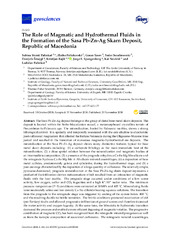| dc.contributor.author | Strmic Palinkas, Sabina | |
| dc.contributor.author | Peltekovski, Zlatko | |
| dc.contributor.author | Tasev, Goran | |
| dc.contributor.author | Serafimovski, Todor | |
| dc.contributor.author | Šmajgl, Danijela | |
| dc.contributor.author | Rajic, Kristijan | |
| dc.contributor.author | Spangenberg, Jorge | |
| dc.contributor.author | Neufeld, Kai | |
| dc.contributor.author | Palinkaš, Ladislav A. | |
| dc.date.accessioned | 2019-07-25T10:45:23Z | |
| dc.date.available | 2019-07-25T10:45:23Z | |
| dc.date.issued | 2018-11-29 | |
| dc.description.abstract | The Sasa Pb-Zn-Ag deposit belongs to the group of distal base metal skarn deposits. The deposit is located within the Serbo-Macedonian massif, a metamorphosed crystalline terrain of Precambrian to Paleozoic age. The mineralization, hosted by Paleozoic marbles, shows a strong lithological control. It is spatially and temporally associated with the calc-alkaline to shoshonitic post-collisional magmatism that affected the Balkan Peninsula during the Oligocene–Miocene time period and resulted in the formation of numerous magmatic–hydrothermal ore deposits. <br>The mineralization at the Sasa Pb-Zn-Ag deposit shows many distinctive features typical for base metal skarn deposits including:<br> (1) a carbonate lithology as the main immediate host of the mineralization; <br>(2) a close spatial relation between the mineralization and magmatic bodies of an intermediate composition; <br>(3) a presence of the prograde anhydrous Ca-Fe-Mg-Mn-silicate and the retrograde hydrous Ca-Fe-Mg-Mn ± Al-silicate mineral assemblages; <br>(4) a deposition of base metal sulfides, predominately galena and sphalerite, during the hydrothermal stage; and <br>(5) a post-ore stage characterized by the deposition of a large quantity of carbonates. The relatively simple, pyroxene-dominated, prograde mineralization at the Sasa Pb-Zn-Ag skarn deposit represents a product of the infiltration-driven metasomatism which resulted from an interaction of magmatic fluids with the host marble. The prograde stage occurred under conditions of a low water activity, low oxygen, sulfur and CO2 fugacities and a high K+/H+ molar ratio. <br>The minimum pressure–temperature (P–T) conditions were estimated at 30 MPa and 405 °C. Mineralizing fluids were moderately saline and low density Ca-Na-chloride bearing aqueous solutions. The transition from the prograde to the retrograde stage was triggered by cooling of the system below 400 °C and the resulting ductile-to-brittle transition. The brittle conditions promoted reactivation of old (pre-Tertiary) faults and allowed progressive infiltration of ground waters and therefore increased the water activity and oxygen fugacity. At the same time, the lithostatic to hydrostatic transition decreased the pressure and enabled a more efficient degassing of magmatic volatiles. The progressive contribution of magmatic CO2 has been recognized from the retrograde mineral paragenesis as well as from the isotopic composition of associated carbonates. The retrograde mineral assemblages, represented by amphiboles, epidote, chlorites, magnetite, pyrrhotite, quartz and carbonates, reflect conditions of high water activity, high oxygen and CO2 fugacities, a gradual increase in the sulfur fugacity and a low K+/H+ molar ratio. Infiltration fluids carried MgCl2 and had a slightly higher salinity compared to the prograde fluids. The maximum formation conditions for the retrograde stage are set at 375 °C and 200 MPa. The deposition of ore minerals, predominantly galena and sphalerite, occurred during the hydrothermal phase under a diminishing influence of magmatic CO2. The mixing of ore-bearing, Mg-Na-chloride or Fe2+-chloride, aqueous solutions with cold and diluted ground waters is the most plausible reason for the destabilization of metal–chloride complexes. However, neutralization of relatively acidic ore-bearing fluids during the interaction with the host lithology could have significantly contributed to the deposition. The post-ore, carbonate-dominated mineralization was deposited from diluted Ca-Na-Cl-bearing fluids of a near-neutral pH composition. The corresponding depositional temperature is estimated at below 300 °C. | en_US |
| dc.description.sponsorship | The early stages of this study were conducted as a part of the project “Geochemical characteristics of hydrothermal ore deposits in the Republic of Macedonia” funded by Croatian Ministry of Science, Education and Sport and Macedonian Ministry of Science. The final part of the study was funded by the project A31566 at UiT The Arctic University of Norway. | en_US |
| dc.description | Published version, available at: <a href=https://doi.org/10.3390/geosciences8120444>https://doi.org/10.3390/geosciences8120444</a> | en_US |
| dc.identifier.citation | Strmic Palinkas, S., Peltekovski, Z., Tasev, G., Serafimovski, T., Šmajgl, D., Rajic, K., Spangenberg, J.E., Neufeld, K., Palinkaš, L. (2018) The Role of Magmatic and Hydrothermal Fluids in the Formation of the Sasa Pb-Zn-Ag Skarn Deposit, Republic of Macedonia. <i>Geosciences. 8</i> (12), 444. https://doi.org/10.3390/geosciences8120444 | en_US |
| dc.identifier.cristinID | FRIDAID 1638232 | |
| dc.identifier.doi | 10.3390/geosciences8120444 | |
| dc.identifier.issn | 2076-3263 | |
| dc.identifier.uri | https://hdl.handle.net/10037/15803 | |
| dc.language.iso | eng | en_US |
| dc.relation.journal | Geosciences | |
| dc.rights.accessRights | openAccess | en_US |
| dc.title | The Role of Magmatic and Hydrothermal Fluids in the Formation of the Sasa Pb-Zn-Ag Skarn Deposit, Republic of Macedonia | en_US |
| dc.type | Journal article | en_US |
| dc.type | Peer reviewed | en_US |


 English
English norsk
norsk